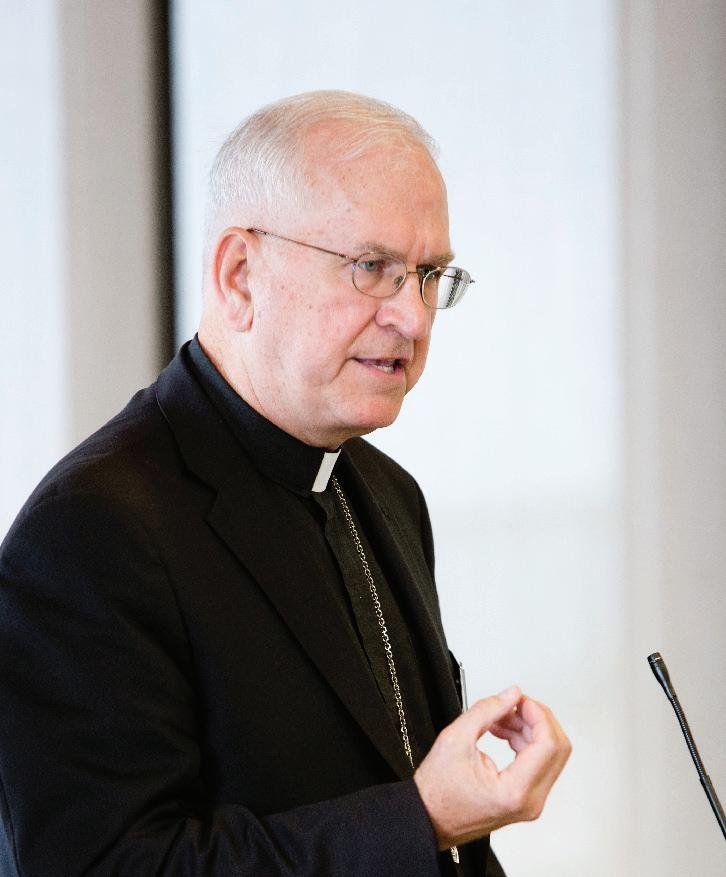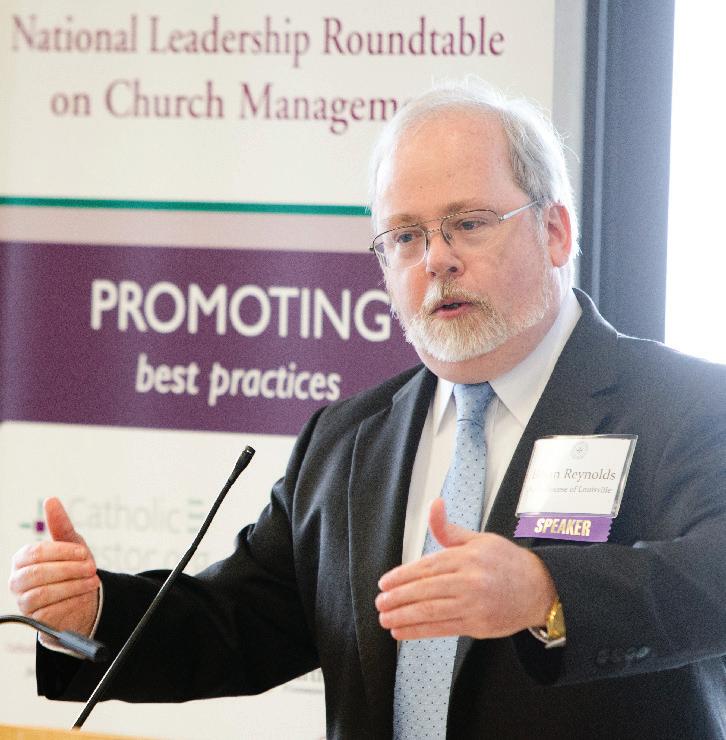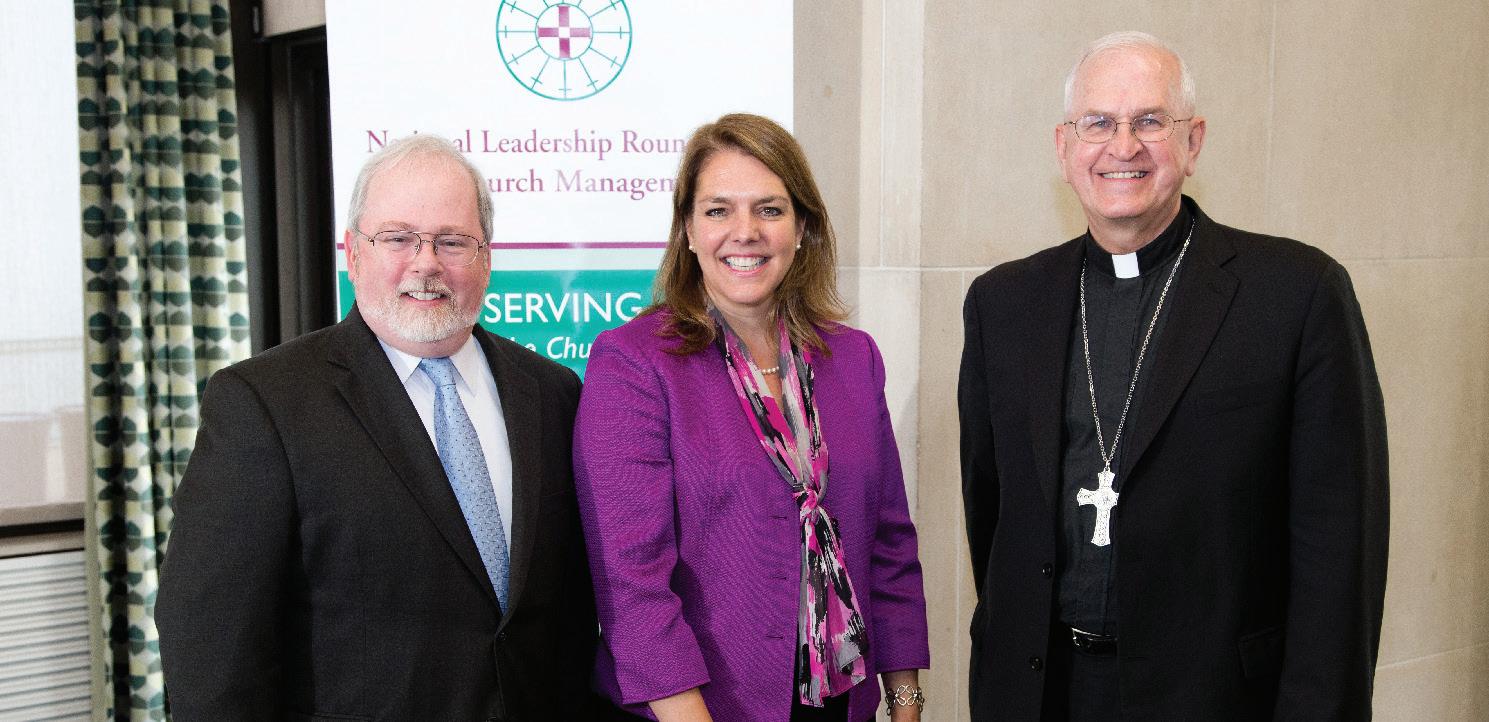
11 minute read
RESPECT, TRUST, AND A ROUND OF GOLF
Most Rev. Joseph Kurtz, Archbishop of Louisville and President, U.S. Conference of Catholic Bishops Brian Reynolds, Chancellor and CAO, Archdiocese of Louisville
Archbishop Joseph Kurtz
Brian and I have worked very closely over the last seven years. And what we’ve tried to do is to present our relationship as a model, though certainly not a perfect one. It’s a model that we ask pastors and lay leaders who are working together on a parish level to examine and to provide feedback so we can improve.
Some of you may know I was involved for many years with Catholic Charities. That experience reinforced the importance of looking at leadership, not just from the standpoint of the kinds of talents, skills, and abilities a person brings to the table, but at the relationships they’ve cultivated with other professionals. In the Archdiocese of Louisville, we’re fond of saying that if we want a healthy Archdiocese, we need to support healthy parishes. And we talk about the relationship between Brian and me as a model of healthy interaction that can be communicated to others.
We’d like to focus on healthy, productive relationships today. Our vehicle will be five specific points – none of them shocking revelations – which we hope will inform and stimulate the conversation.
Brian Reynolds
First, is the importance of having noncrisis interaction to build trust and respect. In other words, don’t wait for a crisis –whether it’s a priest problem, a financial problem, a parish merger, a school closure, a media misunderstanding, whatever – to figure out how you’re going to work together. You need to have some non-crisis activity. And hence the topic of our talk: Respect, Trust, and a Round of Golf.
Respect and trust occur when we take steps to intentionally build them. We don’t wait to see if we can trust each other. We go about building trust by talking things through before a crisis develops. And the round of golf was thrown in simply because it’s important to do things that you both have interest in.
Archbishop Kurtz
I’d like to add something about that noncrisis model of relationship-building. I have observed, even as a pastor and in my Catholic Charities work, that people often don’t give priority to spending the time to develop professional relationships or interactions with one another, so when a crisis occurred and they had to quickly find a solution, they had no foundation on which to build.
“Don’t wait for a crisis - build trust and relationship as standard practice.” @mycatholicvoice #CatholicSFX the final word. If the other person shares my view, then it helps to build a sense of trust and the chance for collaboration.
My own relationship with Brian over these last seven years has been strengthened through several mutually applied principles. The first is giving the other person the benefit of the doubt. No matter who you’re dealing with, that person is going to have a perspective that at times makes you think, “Gee, I wouldn’t have done it that way.” And that’s a healthy place to start because it rests on a trusting attitude of giving the other person the benefit of the doubt.
A second principle that’s enhanced our relationship is giving each other permission to raise questions. For example, if I’ve done something and Brian says, “I’m not sure that’s really the right way to do it,” or vice versa, we give each other permission to raise that question without thinking the ceiling is going to cave in on us. And that goes a long way toward building trust – when we know we don’t have to be perfect and can give permission to question each other’s actions.
A third principle that’s particularly important to me is sharing my initial stand on an issue or matter. If there’s a question on anything – Catholic schools, ministries, finance, development, vocations, choice of pastors – I think it goes a long way for me to share my initial stance, knowing it’s not

The second of the five points we’d like to discuss today is effective methods of communicating with one another. I have what I call my Jell-O theory. When you pour JellO into a mold, there’s the “one-third” and the “two-thirds” of the way effect – where the one-third is still warm and able to shift, while the other two-thirds is starting to jell and not conducive to change. Likewise, Brian and I have given ourselves permission, in cases where something is of great importance, to bring another person into the conversation for the critical one-third where there is a chance to mold the decision and to prepare ourselves for what, in a sense, is coming down the pike. That’s in contrast to eleventh-hour planning.
Another pathway toward effective communications is what I call the strategic triad where if Brian and I are speaking and working together, I ask about the third person that we may need to bring into the conversation. So, in a given year, we might have 15 conversations with one other person where we’re all trying to get on the same page. I’ve tried to use that model, for example, with our Bishop’s Conference. What we’re trying to avoid is an unhealthy triangle where there’s two people in and one person out. That’s a common relationship problem in parenting where you might have a mom and a dad on one page and a child on the other. We’ve especially tried to avoid that triangulation with new staff members. If a person is coming on board in a clearly strategic area, Brian and I will work closely with them to ensure we’re all on the same page.
Brian Reynolds
We’re also always looking for new meth- odologies to enhance our communications and promote dialogue. The Archbishop is very effective at using electronic communications. We use a lot of e-mail and messaging – they’re an important part of how we build trust and how we communicate. Good and open communication also carries over into some of our pastoral activities. For example, the Archbishop does a local television show, which some other dioceses carry, called Conversations with Archbishop Kurtz. It consists of 10-minute segments where I usually interview him for two segments, while another is devoted to the Archbishop interviewing someone else. So here, too, we exhibit good conversation that goes back and forth.
Recapping the points we’ve discussed so far in terms of building respect and trust, there was non-crisis interaction, followed by effective communication. The third point is being publicly accountable. This obviously applies throughout the year, but it’s particularly important in the fall when there seems to occur within the Church a sense of “let’s get everything started at once.” We do a lot of public accountability sessions where the Archbishop and I meet with the Priests’ Council, the Pastoral Council, and small groups of priests. All priests are invited to these meetings to hear the two of us give a report on the state of the Archdiocese. We also meet with major donors and with parish staffs and leaders. That adds up to a pretty heavy workload of about a dozen to 20 meetings over the course of a single month, so that people are getting a sense of accountability from both of us.
“Doing consultation builds a practice of others doing consultation.” @mycatholicvoice
Archbishop Kurtz
There are some side benefits from these public accountability sessions. One is that it’s actually helpful for me to hear how Brian is presenting to others and for him to hear how I’m presenting. Plus, these sessions allow us to listen to people we work with, particularly those in leadership roles. The other thing is how important it is for me to speak well of Brian publicly and for him to do the same for me. People will be able to see if there’s a hollowness to it, so we have to be transparent and speak the truth at all times. Sometimes I observe that in the name of joking, people can subtly tear the other person down –unintentionally. We only have so many opportunities to present ourselves publicly in leadership roles, which is why it’s important to take advantage of each of these.
Brian Reynolds
Here’s another small example of how we divide our roles. When Archbishop Kurtz arrived, we had three seminarians, a number we wanted to increase. A couple years later, we had 17 seminarians. So when we did these accountability reports, the Archbishop would stand up and say, “I’m very excited to tell you we had three seminarians three years ago, and today we have 17.” People would cheer, but I’d inject a note of reality by saying to the group, “Stop! When he came here my seminarian budget was $150,000; now it’s $700,000. Let’s talk about donors.” So, it’s that back and forth with divided roles that adds a useful dimension to the conversation.

Archbishop Kurtz
The fourth of our five points is determining the best person to address a particular issue. We have a team of about five people who work especially well together, just like many of you have a core team that works closely together. In our case, I was always amazed at how well we’re able to determine the best person to solve a problem when it comes to raising money. We always seem to say, “Okay, we have this particular donor; who’s the person most likely to positively influence them?” But we don’t always apply that approach to other situations.
One of the other things we’ve tried to work on over the last seven years is nailing down the best person to reach out to someone in need. It might be a particular pastor, but sometimes we’ll determine that the best and only person is the Archbishop – I need to call that person or go out and visit them. In other cases I might be, for a variety of reasons, the worst person to take on that responsibility. But instead of saying, “We always do it this way;” it’s more important to give ourselves flexibility by saying, “Okay, who would be the best person to do it?” What that does for the group of five or so working together in our Chancery is to build a sort of creativity, a sense of investment and accountability, because we’re collectively saying, “This is not the Archbishop’s problem – let’s see who the best person is to handle it.”
Brian Reynolds
This concept of designating the best person to handle something is really a distilling process. It’s built into our language. When we’re dealing with a question or a problem, we expect any number of people who might be part of the conversation – the Vicar General or the Vicar for Priests, for example – to consider not just the next step but also who is the best person to handle the next step? And the answer isn’t based necessarily on personality or skills. Rather, the key question is, “Who is most likely to achieve the results we’re looking for?”
The last of our five points actually consists of two parts. The first is that we believe it’s really critical in our daily work to employ careful consultation and the use of what we call the critical question approach. Careful consultation is a regular part of our listening process. It doesn’t mean voting on how many people are in favor of this or how many are in favor of that. It means actually taking the time to gather the right people around the table so they can be part of the listening process.
Over the past few years, we’ve used that approach to totally redesign our Finance Council, create a new Development Council, and name a new editorial board for our newspaper. It boils down to consultation through listening – particularly how we listen. Where it works best is using what we call the critical question approach. In our Priests’ Council, Archdiocesan Pastoral Council, and other consultative meetings, we try to never have more than two questions, maybe three, on the table. There’s always some reporting that from needs to occur. But when it comes to what conversations to have, if a small number of topics are on the agenda – not eight, nine, or ten – and you make sure everybody knows about them in advance, then that’s an effective use of our councils’ time. To our minds, just asking “anybody have any questions?” is not consultation. Consultation is where we have two or three focused areas we need to address before we leave today, and we need to hear from everybody who’s here about those things.
It’s interesting to note that the critical question approach enabled us to dramatically redesign our Pastoral Council a number of years ago. The U.S. Conference of Catholic Bishops did a study about the effectiveness of Diocesan Pastoral Councils and discovered that in dioceses where they exist, they’re not particularly effective. We read that study and realized it was true for us as well, so we decided to undertake a redesign. Today, our Archdiocesan Pastoral Council is a convocation model. Every chair of a parish council has a seat on the Pastoral Council. The group convenes twice a year for a full day with the Archbishop and me. This model has given us a valuable tool to get data directly from every parish. And it’s certainly worth noting that Pastoral Council meetings are an opportunity to delve into the two critical questions on the mind of the Archbishop. We may tell the Parish Councils that we’re doing our strategic plan, for example, and we have a couple of issues we need feedback on or perhaps something to do with young adults or with growing cultural diversity in the diocese. So we pose the critical questions to them well in advance of our Pastoral Council meeting and ask the Parish Councils to have that conversation at their next meetings. That typically results in feedback within about 30 days from 60 Parish Councils. It’s a quick and effective process. Plus, the Parish Councils become conditioned to practicing consultation as opposed to discussing what color to paint the lines in the parking lot. It moves them to a conversation on the critical issues that parishes should be addressing.
Archbishop Kurtz
When I arrived seven years ago, I frankly had reservations about the new model of the Archdiocesan Pastoral Council. That’s because I knew that canonically and pastorally the Parish Council is meant to be advisory to the pastor. So I wondered if the Diocesan Pastoral Council was going to create a triangle, which would be perceived by the pastors as the Archbishop intruding into their lives and becoming, in a sense, an indirect way to talk to the pastors. I have to say, though, this has never been an issue. If anything, those priests who are pastors perceive the Pastoral Council as a way of assisting them so they don’t always have to be the funnel for communicating every decision or every issue to everyone. Whenever Brian and I meet with them, we’ll ask, “Who’s new here?” and invariably a third to a half of the attendees are new. So it’s becoming a much wider gathering than just 60 or 70 people, and that’s a very welcome development.
While we’re on the top of consultation, I’d like to point to two important ways I’ve found to be on the receiving end. There needs to be some point in a leader’s life in which he or she privately has an opportunity to mull over what’s happening in their organization. Thus, I prize greatly the one day every month I have to reflect. This personal day allows me to step back and take stock of what’s going on.
During the Pope’s recent message to us on World Communications Day, he stressed that in an increasingly hectic and fast-paced world, we need to create a sense of calm and serenity. And so it would seem to me that consultation, if it’s done right, needs to create an opportunity for us to privately take in that information and, no less importantly, be able to use it. In other words, to begin to see how we can apply the things we’ve learned –perhaps at our next meeting to report back to people and give them an update on timely issues. That helps to build a level of dialogue and communication.
Those are the five key areas around which we believe respect and trust are built. We hope we’ve given you some helpful insights into the small effort in our diocese to build what you might call healthy, productive, and professional relationships.








